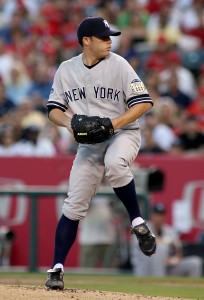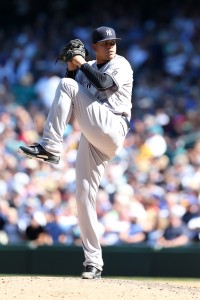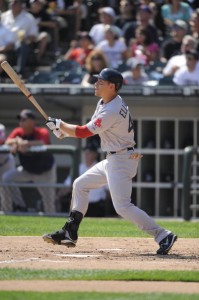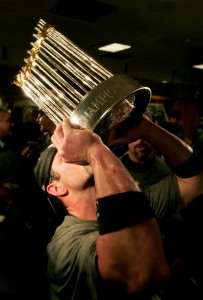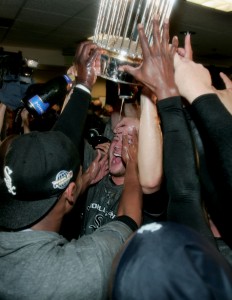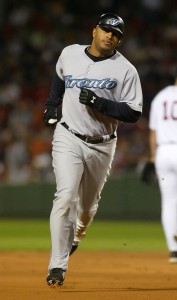All Logan White could do was laugh when I shared my story.
The 2008 Cubs – the winningest team in the National League that season at 97-64 – were taking on the 84-78 Dodgers in the Division Series. At the time, I was a member of the Cubs’ Baseball Operations department.
It was expected to be a quick series, and it was – for Los Angeles. Sure, Manny Ramirez had a thing or two to do with the Dodgers’ three-game sweep, but the big blow in Game 1 was a James Loney grand slam. For good measure, Russell Martin also went deep later in the contest. In Game 2, Chad Billingsley stifled Cubs bats, allowing one run in 6.2 innings while fanning seven. In Game 3, Jonathan Broxton had his third scoreless appearance of the NLDS in picking up the save and completing the sweep.
“That was a lot of fun,” said White, who is now in his third year with the Padres after spending 13 years up the coast in Los Angeles. In his first two Dodgers drafts in 2002 and 2003, White’s combined haul included Loney, Martin, Billingsley, Broxton, Matt Kemp and A.J. Ellis, along with nine others who spent time in the Majors. “What wasn’t fun is we could never get to the big dance. And you know how hard that is, obviously. It’s tough to get to the big game, and that was my only regret when I was in L.A. – never getting to the World Series.
“That’s what keeps us going. That’s what we’re trying to do in San Diego now. We’re trying to rebuild the farm and everything. Hopefully, at some point, we’ll have some young players like you saw in those Dodgers days.”
– – –
Going back to the early years of the draft – heck, you can really go back to their Brooklyn days and Branch Rickey – the Dodgers have had a reputation for player development and scouting.
Baseball America still calls the Dodgers’ class of 1968 “the best in draft annals,” as the team selected Ron Cey, Steve Garvey, Davey Lopes, Bill Buckner, Doyle Alexander, Geoff Zahn, Joe Ferguson, Tom Paciorek and Bobby Valentine.
But after years of draft success, Los Angeles then had a dry spell. While the 1993 draft brought a couple solid longtime Dodgers in Darren Dreifort and Paul Lo Duca, there was very little cause to pat themselves on the back from 1994-2001. Granted, there were a few solid hits – Paul Konerko (1994), Ted Lilly (1996) and Shane Victorino (1999) – but those three made their biggest impact with other organizations.
In November 2001, the Dodgers turned to Logan White to return their scouting department to its glory days.
A former relief pitcher in Seattle’s farm system, White began his scouting career in 1988 as an associate scout with the Mariners. He had stints as the West Coast supervisor for San Diego (1993-1995) and Baltimore (1996-2001) en route to Los Angeles.
Upon joining the Dodgers’ organization, White brought with him a very high school-centric draft philosophy.
“I think my approach developed from watching others,” he said. “Having been around Don Welke – who was a mentor of mine and worked for Toronto for a long time, and being around Pat Gillick, and in watching the Atlanta Braves during that period of time … when you look at them, they drafted a lot of high-ceiling players and high school players. What I found out was … if you’re picking in the top 10 of the draft, there’s a lot of good scouts and evaluators out there, so teams generally will take the good college player up there.
“We were picking 19th in 2002 and 24th in 2003. My research showed that you’d better know the high school player there because the quality college players that everyone knows have already been taken. Now, there are exceptions to that rule, of course. Mike Mussina went 20th for the Orioles when I was there (in 1990), that type of thing. But there was some philosophy behind it; I didn’t look at it as analytics at the time, but I did research on it.
“The other thing … there was a dynamic that happened in 2002 and 2003. That was the beginning of the ‘Moneyball’ years where teams – it wasn’t just Oakland – were drafting heavily from college. That was their philosophy and a lot of teams did well at it. So maybe 10 or 15 of them weren’t drafting from the high school pool. It just left a bigger pool of talent for us at the high school level in those years. So it was kind of by design and by circumstance, if that makes sense.
“At the same time, we were just trying to draft the best available player who we thought had the highest ceiling. For example, let’s say there would be a college player we liked. We mixed our high school and college players together on the draft board. The college player would be pushed down a little further. Well, now you take another team and they’re only ranking college players. The college player gets ranked higher on their board. Say there’s a college player we would have liked to take in round three. But shoot, he went in round two or at the end of the first round to one of the teams selecting only from the college pool.
“It left us more high school players. It’s really how the draft fell because we liked a number of college guys. Heck, we liked Nick Swisher, but Swisher went before we picked.”
Swisher, who had attended Ohio State, was taken at No. 16 in the 2002 draft by Oakland.
“That’s kind of how those drafts unfolded,” White said. “But we did focus on the high school player. That was definitely by design.”
The 2002 and 2003 drafts were very different for the Dodgers in terms of volume of picks – in ’02, the team gained two additional selections as compensation for the loss of free agent Chan Ho Park to Texas; in ’03, the club only had one pick in the top 60 – but not in terms of a common theme. In his first year as a scouting director, White didn’t select a four-year college player until his ninth pick. In his second year, his first eight picks – and 13 of his first 15 – were high school players.Read more
